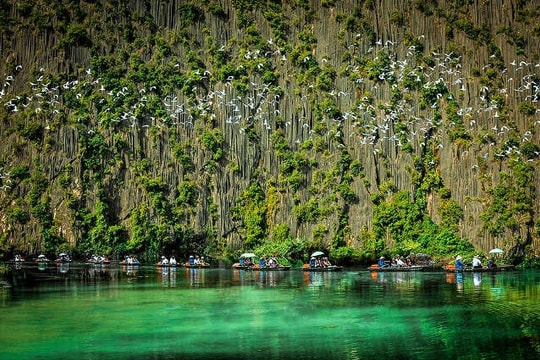Vân Long Wetland Nature Reserve, located in Ninh Bình province, Vietnam, is recognized as one of the most important conservation areas, both ecologically and for its rich biodiversity. It is the largest wetland in the northern region of Vietnam, famous for its diverse ecosystems and stunning landscapes. This reserve is also a popular ecotourism destination, attracting many domestic and international visitors.
1. Location and Area
Location: Vân Long Nature Reserve is situated in Gia Viễn District, Ninh Bình Province, about 15 km southwest of Ninh Bình City. It is a freshwater wetland surrounded by majestic limestone mountains and typical wetland ecosystems.
Area: The reserve spans an area of 3,500 hectares, primarily consisting of wetlands, lakes, and canal ecosystems.
2. Ecological Features
Wetland Ecosystem: Vân Long is a wetland area with typical ecosystems such as marshes, flooded fields, and swamp forests. The plants here have adapted to the flooded environment that persists year-round.
Wildlife: The reserve is home to numerous rare and valuable species, particularly the endangered species of primate, the Delacour’s langur (Trachypithecus delacouri), which is listed in Vietnam’s Red Book. Additionally, Vân Long serves as a habitat for many migratory bird species, fish, shrimp, and other wildlife.
Flora: In addition to aquatic plants like grasses, mangroves, and reeds, the reserve also supports a diverse range of wild plants, aquatic species, and medicinal plants, which are essential for maintaining ecological balance and protecting the environment.
3. Environmental Protection Role
Preventing Erosion and Protecting Soil: The wetland areas in Vân Long play a vital role in water retention, preventing soil erosion, and protecting surrounding agricultural areas.
Water Quality Protection: The reserve plays an important role in maintaining water quality, regulating water flow in rivers and canals, and protecting aquatic habitats.
4. Ecotourism Activities
Ecotourism: Vân Long is one of the prominent ecotourism destinations in Ninh Bình, with its majestic landscapes and rich biodiversity. Visitors can engage in activities such as visiting marshlands, bird watching, boating on the lakes, and exploring the unique flora and fauna of the reserve.
Environmental Education: Visitors not only enjoy the natural beauty of Vân Long but also learn about conservation efforts and the importance of wetland ecosystems in sustaining life and protecting the environment.
5. Conservation and Management
Management and Conservation: Vân Long Nature Reserve is managed and protected by government authorities to maintain and develop its ecosystems, ensuring the conservation of rare animal and plant species. Local and national conservation organizations are actively running programs to protect endemic species and safeguard the reserve’s natural habitats.
Wildlife Protection Programs: Programs are in place to protect the Delacour’s langur, migratory birds, and other endangered animals, helping to maintain wildlife populations and protect biodiversity within the reserve.
6. Importance to the Local Community
Sustainable Development: Vân Long Nature Reserve not only holds ecological value but also plays a significant role in sustainable tourism development. Ecotourism helps raise environmental awareness and provides a source of income for the local community, supporting economic growth while preserving natural resources and the environment.
7. Conservation Programs
Delacour’s Langur Protection: Vân Long is the only place in Vietnam where the Delacour’s langur population is found. Conservation programs for this endangered species include research, monitoring, and habitat protection efforts.
Bird and Aquatic Life Conservation: The reserve also focuses on programs to protect migratory birds and aquatic species, aiming to maintain biodiversity and protect species at risk of extinction.
With its distinctive ecosystem and rich biodiversity, Vân Long Wetland Nature Reserve is one of the most important conservation areas in Vietnam. It is not only a major ecotourism destination but also a vital site for nature conservation and sustainable development in the region.



